Key Elements for Effective Email Communication in Business
VerifiedAdded on 2023/06/12
|7
|2205
|189
Essay
AI Summary
This essay explores the key elements necessary for effective email communication in a business or professional context. It emphasizes the importance of understanding the audience, using appropriate language, content, and formatting, and being aware of how noise can affect the message's interpretation. The essay also discusses the significance of choosing the most appropriate communication channel and highlights the need for a clear strategy to foster benefits for the company, including concise and direct messaging, transparency, and a professional attitude. Furthermore, it addresses the structure of an effective email, including the relevance of the subject line, the content's clarity and conciseness, and the importance of grammatical correctness and quick response times. The essay concludes by advocating for the enhancement of emailing business communication to eradicate problems erected by inefficient communicative strategies.
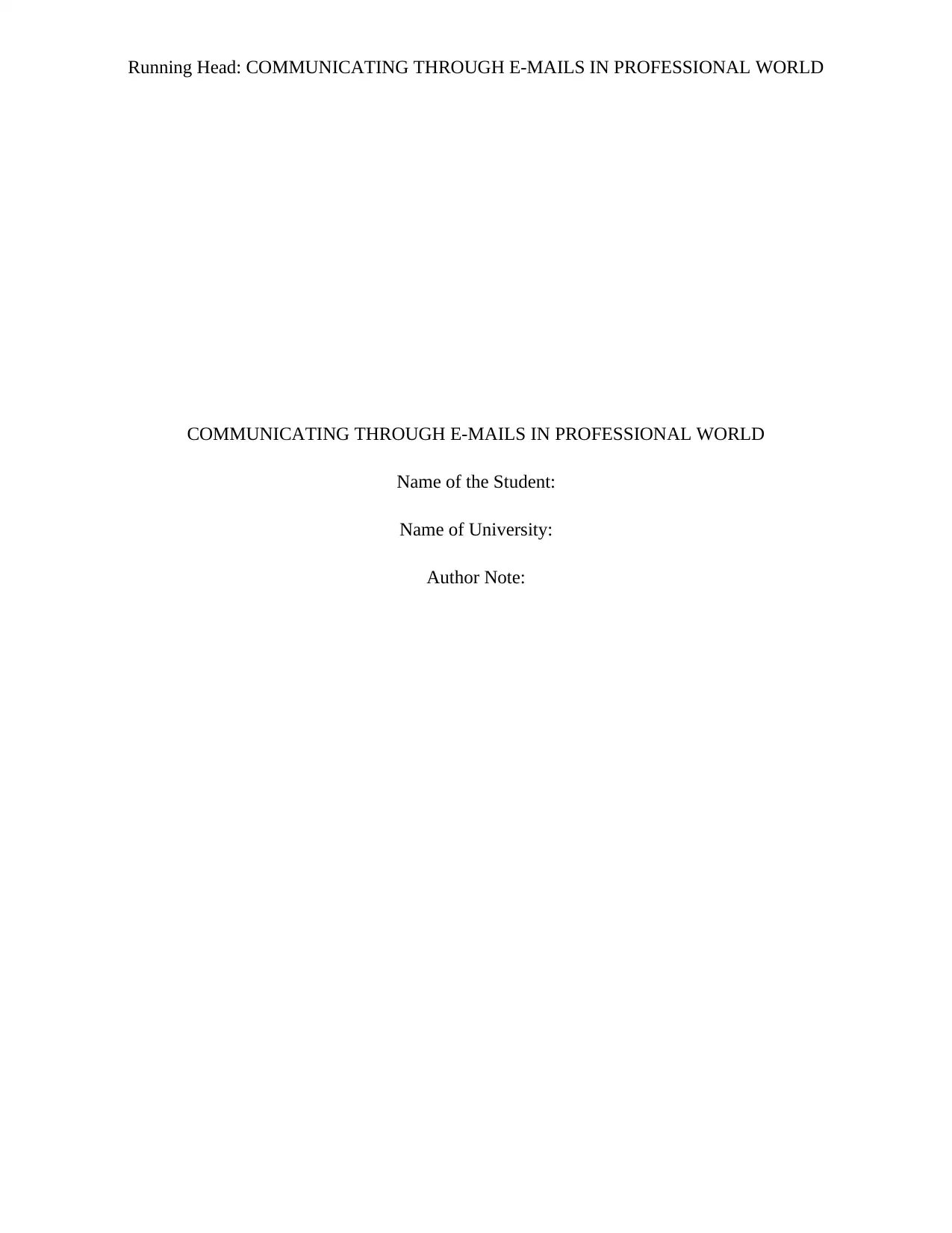
Running Head: COMMUNICATING THROUGH E-MAILS IN PROFESSIONAL WORLD
COMMUNICATING THROUGH E-MAILS IN PROFESSIONAL WORLD
Name of the Student:
Name of University:
Author Note:
COMMUNICATING THROUGH E-MAILS IN PROFESSIONAL WORLD
Name of the Student:
Name of University:
Author Note:
Paraphrase This Document
Need a fresh take? Get an instant paraphrase of this document with our AI Paraphraser
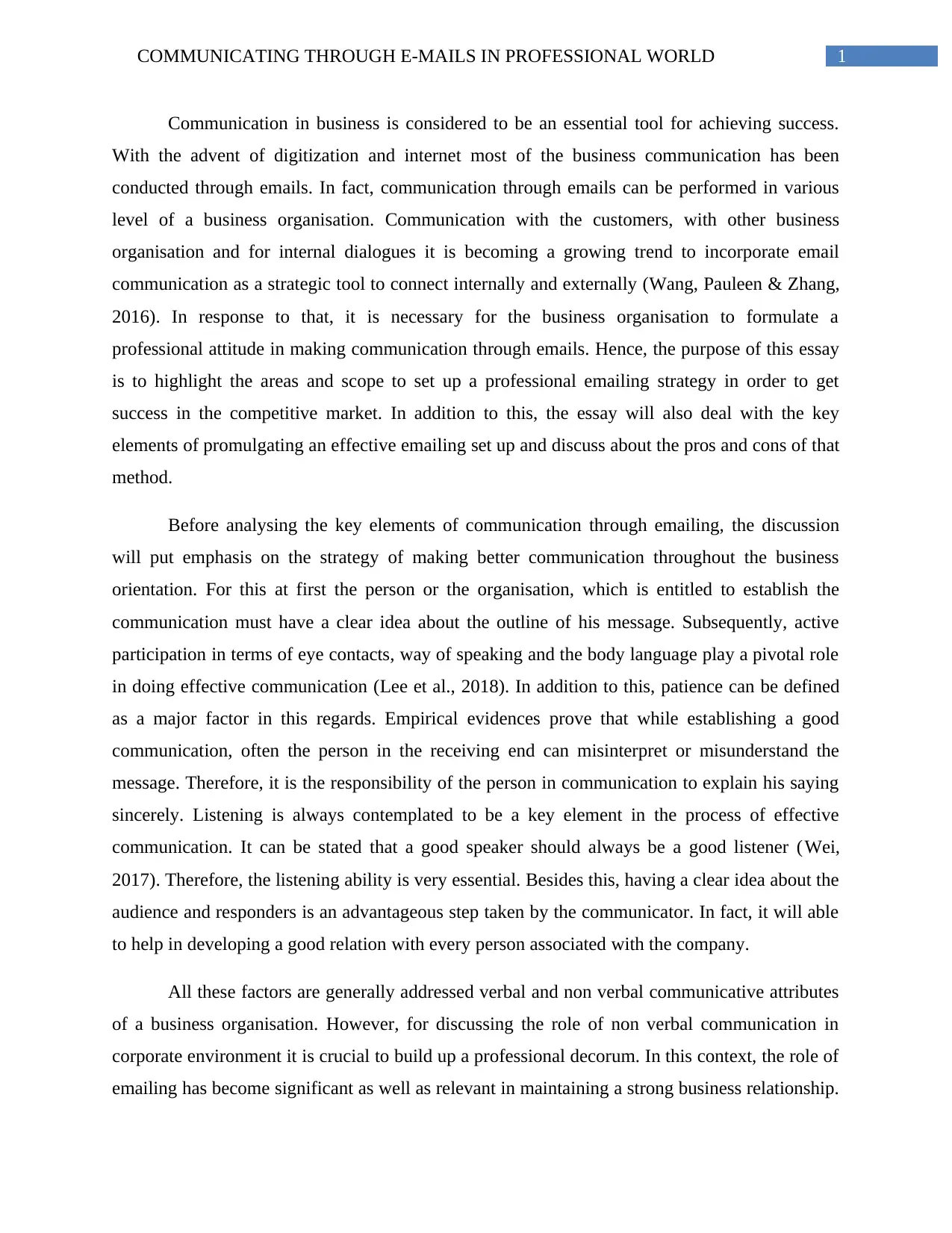
1COMMUNICATING THROUGH E-MAILS IN PROFESSIONAL WORLD
Communication in business is considered to be an essential tool for achieving success.
With the advent of digitization and internet most of the business communication has been
conducted through emails. In fact, communication through emails can be performed in various
level of a business organisation. Communication with the customers, with other business
organisation and for internal dialogues it is becoming a growing trend to incorporate email
communication as a strategic tool to connect internally and externally (Wang, Pauleen & Zhang,
2016). In response to that, it is necessary for the business organisation to formulate a
professional attitude in making communication through emails. Hence, the purpose of this essay
is to highlight the areas and scope to set up a professional emailing strategy in order to get
success in the competitive market. In addition to this, the essay will also deal with the key
elements of promulgating an effective emailing set up and discuss about the pros and cons of that
method.
Before analysing the key elements of communication through emailing, the discussion
will put emphasis on the strategy of making better communication throughout the business
orientation. For this at first the person or the organisation, which is entitled to establish the
communication must have a clear idea about the outline of his message. Subsequently, active
participation in terms of eye contacts, way of speaking and the body language play a pivotal role
in doing effective communication (Lee et al., 2018). In addition to this, patience can be defined
as a major factor in this regards. Empirical evidences prove that while establishing a good
communication, often the person in the receiving end can misinterpret or misunderstand the
message. Therefore, it is the responsibility of the person in communication to explain his saying
sincerely. Listening is always contemplated to be a key element in the process of effective
communication. It can be stated that a good speaker should always be a good listener (Wei,
2017). Therefore, the listening ability is very essential. Besides this, having a clear idea about the
audience and responders is an advantageous step taken by the communicator. In fact, it will able
to help in developing a good relation with every person associated with the company.
All these factors are generally addressed verbal and non verbal communicative attributes
of a business organisation. However, for discussing the role of non verbal communication in
corporate environment it is crucial to build up a professional decorum. In this context, the role of
emailing has become significant as well as relevant in maintaining a strong business relationship.
Communication in business is considered to be an essential tool for achieving success.
With the advent of digitization and internet most of the business communication has been
conducted through emails. In fact, communication through emails can be performed in various
level of a business organisation. Communication with the customers, with other business
organisation and for internal dialogues it is becoming a growing trend to incorporate email
communication as a strategic tool to connect internally and externally (Wang, Pauleen & Zhang,
2016). In response to that, it is necessary for the business organisation to formulate a
professional attitude in making communication through emails. Hence, the purpose of this essay
is to highlight the areas and scope to set up a professional emailing strategy in order to get
success in the competitive market. In addition to this, the essay will also deal with the key
elements of promulgating an effective emailing set up and discuss about the pros and cons of that
method.
Before analysing the key elements of communication through emailing, the discussion
will put emphasis on the strategy of making better communication throughout the business
orientation. For this at first the person or the organisation, which is entitled to establish the
communication must have a clear idea about the outline of his message. Subsequently, active
participation in terms of eye contacts, way of speaking and the body language play a pivotal role
in doing effective communication (Lee et al., 2018). In addition to this, patience can be defined
as a major factor in this regards. Empirical evidences prove that while establishing a good
communication, often the person in the receiving end can misinterpret or misunderstand the
message. Therefore, it is the responsibility of the person in communication to explain his saying
sincerely. Listening is always contemplated to be a key element in the process of effective
communication. It can be stated that a good speaker should always be a good listener (Wei,
2017). Therefore, the listening ability is very essential. Besides this, having a clear idea about the
audience and responders is an advantageous step taken by the communicator. In fact, it will able
to help in developing a good relation with every person associated with the company.
All these factors are generally addressed verbal and non verbal communicative attributes
of a business organisation. However, for discussing the role of non verbal communication in
corporate environment it is crucial to build up a professional decorum. In this context, the role of
emailing has become significant as well as relevant in maintaining a strong business relationship.
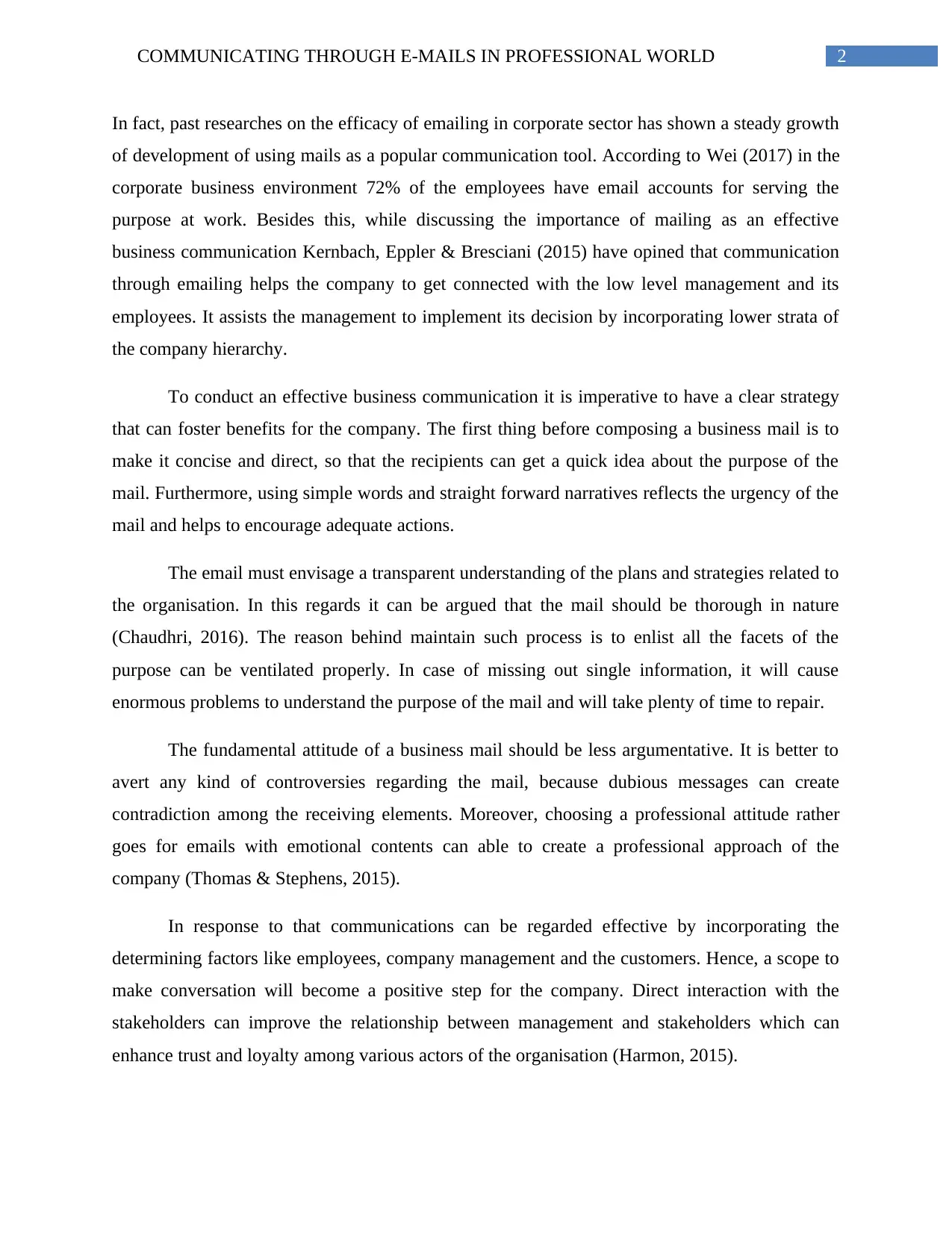
2COMMUNICATING THROUGH E-MAILS IN PROFESSIONAL WORLD
In fact, past researches on the efficacy of emailing in corporate sector has shown a steady growth
of development of using mails as a popular communication tool. According to Wei (2017) in the
corporate business environment 72% of the employees have email accounts for serving the
purpose at work. Besides this, while discussing the importance of mailing as an effective
business communication Kernbach, Eppler & Bresciani (2015) have opined that communication
through emailing helps the company to get connected with the low level management and its
employees. It assists the management to implement its decision by incorporating lower strata of
the company hierarchy.
To conduct an effective business communication it is imperative to have a clear strategy
that can foster benefits for the company. The first thing before composing a business mail is to
make it concise and direct, so that the recipients can get a quick idea about the purpose of the
mail. Furthermore, using simple words and straight forward narratives reflects the urgency of the
mail and helps to encourage adequate actions.
The email must envisage a transparent understanding of the plans and strategies related to
the organisation. In this regards it can be argued that the mail should be thorough in nature
(Chaudhri, 2016). The reason behind maintain such process is to enlist all the facets of the
purpose can be ventilated properly. In case of missing out single information, it will cause
enormous problems to understand the purpose of the mail and will take plenty of time to repair.
The fundamental attitude of a business mail should be less argumentative. It is better to
avert any kind of controversies regarding the mail, because dubious messages can create
contradiction among the receiving elements. Moreover, choosing a professional attitude rather
goes for emails with emotional contents can able to create a professional approach of the
company (Thomas & Stephens, 2015).
In response to that communications can be regarded effective by incorporating the
determining factors like employees, company management and the customers. Hence, a scope to
make conversation will become a positive step for the company. Direct interaction with the
stakeholders can improve the relationship between management and stakeholders which can
enhance trust and loyalty among various actors of the organisation (Harmon, 2015).
In fact, past researches on the efficacy of emailing in corporate sector has shown a steady growth
of development of using mails as a popular communication tool. According to Wei (2017) in the
corporate business environment 72% of the employees have email accounts for serving the
purpose at work. Besides this, while discussing the importance of mailing as an effective
business communication Kernbach, Eppler & Bresciani (2015) have opined that communication
through emailing helps the company to get connected with the low level management and its
employees. It assists the management to implement its decision by incorporating lower strata of
the company hierarchy.
To conduct an effective business communication it is imperative to have a clear strategy
that can foster benefits for the company. The first thing before composing a business mail is to
make it concise and direct, so that the recipients can get a quick idea about the purpose of the
mail. Furthermore, using simple words and straight forward narratives reflects the urgency of the
mail and helps to encourage adequate actions.
The email must envisage a transparent understanding of the plans and strategies related to
the organisation. In this regards it can be argued that the mail should be thorough in nature
(Chaudhri, 2016). The reason behind maintain such process is to enlist all the facets of the
purpose can be ventilated properly. In case of missing out single information, it will cause
enormous problems to understand the purpose of the mail and will take plenty of time to repair.
The fundamental attitude of a business mail should be less argumentative. It is better to
avert any kind of controversies regarding the mail, because dubious messages can create
contradiction among the receiving elements. Moreover, choosing a professional attitude rather
goes for emails with emotional contents can able to create a professional approach of the
company (Thomas & Stephens, 2015).
In response to that communications can be regarded effective by incorporating the
determining factors like employees, company management and the customers. Hence, a scope to
make conversation will become a positive step for the company. Direct interaction with the
stakeholders can improve the relationship between management and stakeholders which can
enhance trust and loyalty among various actors of the organisation (Harmon, 2015).
⊘ This is a preview!⊘
Do you want full access?
Subscribe today to unlock all pages.

Trusted by 1+ million students worldwide

3COMMUNICATING THROUGH E-MAILS IN PROFESSIONAL WORLD
In addition to this, checking the data and facts which are mentioned in the emails should
be a priority for the company before composing a mail. It has to be kept in mind that the success
of a company depends on its professionalism and sharing valuable data to the stakeholders.
Positive information has the power to motivate the playing actors and they will put more concern
about the company.
Despite taking precautionary actions before drafting a mail the management must possess
a clear idea about the consequences of the mails and the subject that the mail is ought to reflect.
In addition to this, it is also necessary for the company to keep focus on the structure of the mail.
Therefore, it is imperative to follow some steps regarding an effective communication through
emails.
In this context, relevance of the mail is a very significant element. The organisation must
have opted for a relevant mail where all the key factors that the company wants to address should
be highlighted. Furthermore, emails cannot be considered as the best means of communication in
every situation, so that, this limitation should not be undermined (Dulek & Campbell, 2015).
As a matter of fact, the subject line of the emails plays a pivotal part in acknowledging a
brief perspective of the topic. Hence, the subject line should be specifically short and relevant
with the subject. The subject line is similar to the newspaper headline to some extent which
resembles the key concept of the main body (Kwiatkowski, 2016). Therefore, the subject line
must be concise and straight forward.
After that, the most important part of the mail comes, comprised with the content of the
subject. The main body or the content part should be direct, formal and contains data and
information regarding the main idea of the subject. However, in most of the cases it can be seen
that the content is less informative and lack of structural point of discussion. In fact, the length of
the email is also an essential part. Lengthy discussion on the topic can undermine the importance
of the purpose because most of the time people do not have enough time to go through such long
mail (Tang, Pei & Luk, 2014). Therefore, it is essential to compose the content to the point and
direct.
The way of speech or the tone of the email perceives the reflection of professionalism.
Therefore, maintaining a good gesture with more emphasis on choice of words is primary to
In addition to this, checking the data and facts which are mentioned in the emails should
be a priority for the company before composing a mail. It has to be kept in mind that the success
of a company depends on its professionalism and sharing valuable data to the stakeholders.
Positive information has the power to motivate the playing actors and they will put more concern
about the company.
Despite taking precautionary actions before drafting a mail the management must possess
a clear idea about the consequences of the mails and the subject that the mail is ought to reflect.
In addition to this, it is also necessary for the company to keep focus on the structure of the mail.
Therefore, it is imperative to follow some steps regarding an effective communication through
emails.
In this context, relevance of the mail is a very significant element. The organisation must
have opted for a relevant mail where all the key factors that the company wants to address should
be highlighted. Furthermore, emails cannot be considered as the best means of communication in
every situation, so that, this limitation should not be undermined (Dulek & Campbell, 2015).
As a matter of fact, the subject line of the emails plays a pivotal part in acknowledging a
brief perspective of the topic. Hence, the subject line should be specifically short and relevant
with the subject. The subject line is similar to the newspaper headline to some extent which
resembles the key concept of the main body (Kwiatkowski, 2016). Therefore, the subject line
must be concise and straight forward.
After that, the most important part of the mail comes, comprised with the content of the
subject. The main body or the content part should be direct, formal and contains data and
information regarding the main idea of the subject. However, in most of the cases it can be seen
that the content is less informative and lack of structural point of discussion. In fact, the length of
the email is also an essential part. Lengthy discussion on the topic can undermine the importance
of the purpose because most of the time people do not have enough time to go through such long
mail (Tang, Pei & Luk, 2014). Therefore, it is essential to compose the content to the point and
direct.
The way of speech or the tone of the email perceives the reflection of professionalism.
Therefore, maintaining a good gesture with more emphasis on choice of words is primary to
Paraphrase This Document
Need a fresh take? Get an instant paraphrase of this document with our AI Paraphraser

4COMMUNICATING THROUGH E-MAILS IN PROFESSIONAL WORLD
construct a mail. Politeness, wise term coinage and using simple and suitable word are necessary
to determine the effectiveness of email communication in business.
In addition to this, language can be the next factor of developing a better business
communication. Grammatically correct with proper use of punctuation have to be maintained.
The company has to keep in mind that all the recipients can understand the meaning and value of
the email (Eisenberg, Johnson & Pieterson, 2015). Lack of grammatical correctness and spelling
mistakes are indicated the incompetency and incompleteness of the sender. Moreover, these
kinds of mistakes can undermine the gravity of the message and will create an obstacle for the
further strategies that the company is going to take.
Besides this, it is also imperative for the email sender to become a quick responder. It
also symbolizes good email etiquette with a reflection of the urgency of the task. Moreover, a
short but quick reply can identify professionalism and level of urgency of the mail (Cristina,
Karam & Andreea, 2017).
Despite all the measures taken for creating an effective business communication through
email there are always a possibility to create a communication gap by using non-verbal
communicative tools. Henceforth, the success of non-verbal communication does not prove the
limitation of the mechanism. Inconsistency, difference of interpretation and misunderstanding
related to the subject, all are the possibilities of accessing indirect communication. However, the
purpose of this essay is to make a good and effective emailing business communication. The
reason behind choosing this topic as a discussion is to eradicate the problems that are erected by
using emailing communicative strategy. The arguments are strongly dedicated to enhance the
efficacy of emailing business communication and in order to do that the essay had mentioned a
process to develop the email communication more efficient and pragmatic.
construct a mail. Politeness, wise term coinage and using simple and suitable word are necessary
to determine the effectiveness of email communication in business.
In addition to this, language can be the next factor of developing a better business
communication. Grammatically correct with proper use of punctuation have to be maintained.
The company has to keep in mind that all the recipients can understand the meaning and value of
the email (Eisenberg, Johnson & Pieterson, 2015). Lack of grammatical correctness and spelling
mistakes are indicated the incompetency and incompleteness of the sender. Moreover, these
kinds of mistakes can undermine the gravity of the message and will create an obstacle for the
further strategies that the company is going to take.
Besides this, it is also imperative for the email sender to become a quick responder. It
also symbolizes good email etiquette with a reflection of the urgency of the task. Moreover, a
short but quick reply can identify professionalism and level of urgency of the mail (Cristina,
Karam & Andreea, 2017).
Despite all the measures taken for creating an effective business communication through
email there are always a possibility to create a communication gap by using non-verbal
communicative tools. Henceforth, the success of non-verbal communication does not prove the
limitation of the mechanism. Inconsistency, difference of interpretation and misunderstanding
related to the subject, all are the possibilities of accessing indirect communication. However, the
purpose of this essay is to make a good and effective emailing business communication. The
reason behind choosing this topic as a discussion is to eradicate the problems that are erected by
using emailing communicative strategy. The arguments are strongly dedicated to enhance the
efficacy of emailing business communication and in order to do that the essay had mentioned a
process to develop the email communication more efficient and pragmatic.
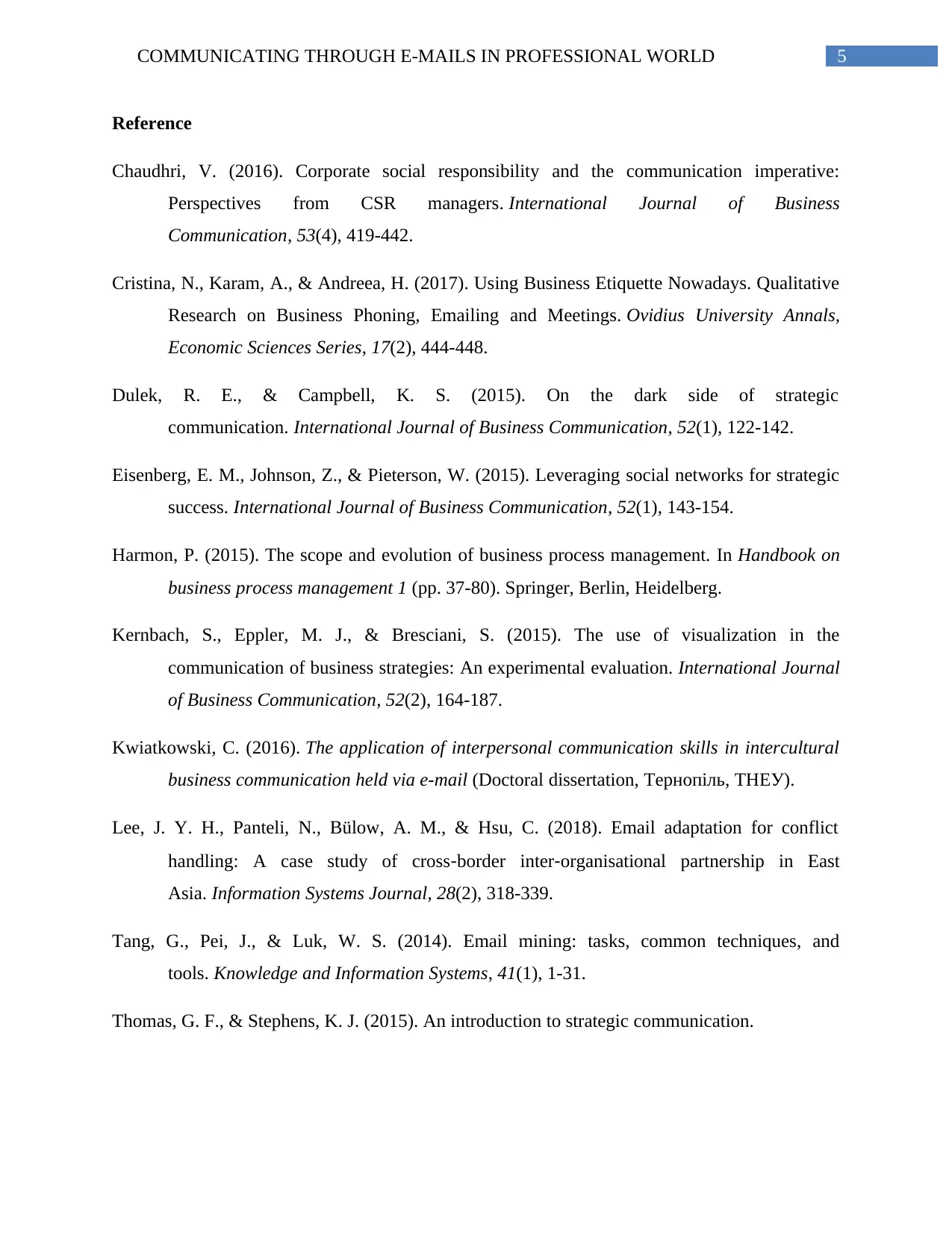
5COMMUNICATING THROUGH E-MAILS IN PROFESSIONAL WORLD
Reference
Chaudhri, V. (2016). Corporate social responsibility and the communication imperative:
Perspectives from CSR managers. International Journal of Business
Communication, 53(4), 419-442.
Cristina, N., Karam, A., & Andreea, H. (2017). Using Business Etiquette Nowadays. Qualitative
Research on Business Phoning, Emailing and Meetings. Ovidius University Annals,
Economic Sciences Series, 17(2), 444-448.
Dulek, R. E., & Campbell, K. S. (2015). On the dark side of strategic
communication. International Journal of Business Communication, 52(1), 122-142.
Eisenberg, E. M., Johnson, Z., & Pieterson, W. (2015). Leveraging social networks for strategic
success. International Journal of Business Communication, 52(1), 143-154.
Harmon, P. (2015). The scope and evolution of business process management. In Handbook on
business process management 1 (pp. 37-80). Springer, Berlin, Heidelberg.
Kernbach, S., Eppler, M. J., & Bresciani, S. (2015). The use of visualization in the
communication of business strategies: An experimental evaluation. International Journal
of Business Communication, 52(2), 164-187.
Kwiatkowski, C. (2016). The application of interpersonal communication skills in intercultural
business communication held via e-mail (Doctoral dissertation, Тернопіль, ТНЕУ).
Lee, J. Y. H., Panteli, N., Bülow, A. M., & Hsu, C. (2018). Email adaptation for conflict
handling: A case study of cross‐border inter‐organisational partnership in East
Asia. Information Systems Journal, 28(2), 318-339.
Tang, G., Pei, J., & Luk, W. S. (2014). Email mining: tasks, common techniques, and
tools. Knowledge and Information Systems, 41(1), 1-31.
Thomas, G. F., & Stephens, K. J. (2015). An introduction to strategic communication.
Reference
Chaudhri, V. (2016). Corporate social responsibility and the communication imperative:
Perspectives from CSR managers. International Journal of Business
Communication, 53(4), 419-442.
Cristina, N., Karam, A., & Andreea, H. (2017). Using Business Etiquette Nowadays. Qualitative
Research on Business Phoning, Emailing and Meetings. Ovidius University Annals,
Economic Sciences Series, 17(2), 444-448.
Dulek, R. E., & Campbell, K. S. (2015). On the dark side of strategic
communication. International Journal of Business Communication, 52(1), 122-142.
Eisenberg, E. M., Johnson, Z., & Pieterson, W. (2015). Leveraging social networks for strategic
success. International Journal of Business Communication, 52(1), 143-154.
Harmon, P. (2015). The scope and evolution of business process management. In Handbook on
business process management 1 (pp. 37-80). Springer, Berlin, Heidelberg.
Kernbach, S., Eppler, M. J., & Bresciani, S. (2015). The use of visualization in the
communication of business strategies: An experimental evaluation. International Journal
of Business Communication, 52(2), 164-187.
Kwiatkowski, C. (2016). The application of interpersonal communication skills in intercultural
business communication held via e-mail (Doctoral dissertation, Тернопіль, ТНЕУ).
Lee, J. Y. H., Panteli, N., Bülow, A. M., & Hsu, C. (2018). Email adaptation for conflict
handling: A case study of cross‐border inter‐organisational partnership in East
Asia. Information Systems Journal, 28(2), 318-339.
Tang, G., Pei, J., & Luk, W. S. (2014). Email mining: tasks, common techniques, and
tools. Knowledge and Information Systems, 41(1), 1-31.
Thomas, G. F., & Stephens, K. J. (2015). An introduction to strategic communication.
⊘ This is a preview!⊘
Do you want full access?
Subscribe today to unlock all pages.

Trusted by 1+ million students worldwide
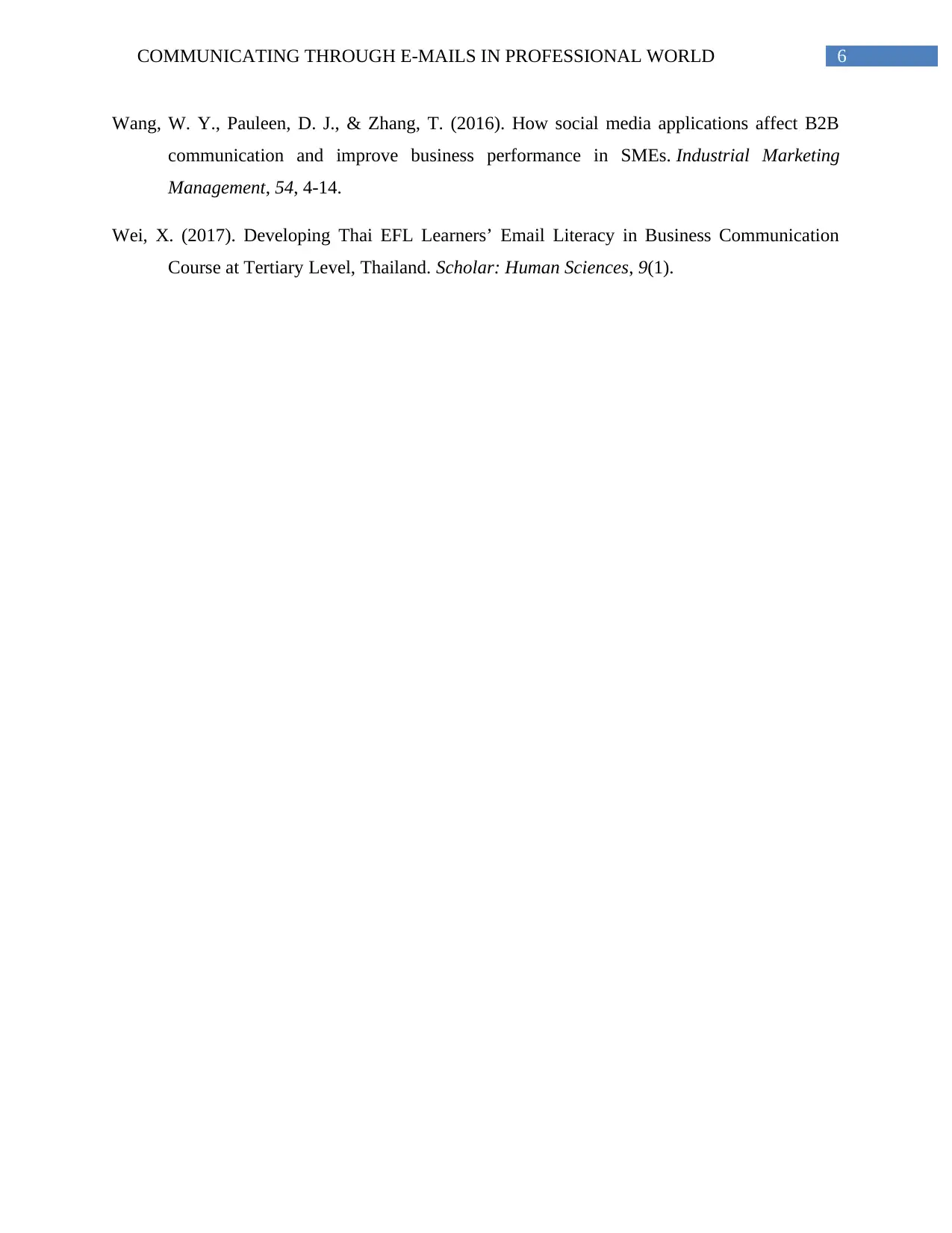
6COMMUNICATING THROUGH E-MAILS IN PROFESSIONAL WORLD
Wang, W. Y., Pauleen, D. J., & Zhang, T. (2016). How social media applications affect B2B
communication and improve business performance in SMEs. Industrial Marketing
Management, 54, 4-14.
Wei, X. (2017). Developing Thai EFL Learners’ Email Literacy in Business Communication
Course at Tertiary Level, Thailand. Scholar: Human Sciences, 9(1).
Wang, W. Y., Pauleen, D. J., & Zhang, T. (2016). How social media applications affect B2B
communication and improve business performance in SMEs. Industrial Marketing
Management, 54, 4-14.
Wei, X. (2017). Developing Thai EFL Learners’ Email Literacy in Business Communication
Course at Tertiary Level, Thailand. Scholar: Human Sciences, 9(1).
1 out of 7
Related Documents
Your All-in-One AI-Powered Toolkit for Academic Success.
+13062052269
info@desklib.com
Available 24*7 on WhatsApp / Email
![[object Object]](/_next/static/media/star-bottom.7253800d.svg)
Unlock your academic potential
Copyright © 2020–2025 A2Z Services. All Rights Reserved. Developed and managed by ZUCOL.




